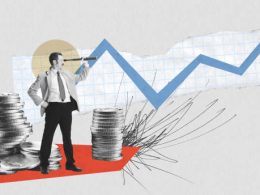In the current economic climate, savers in the US are facing a tough challenge. With deposit rates at all-time lows and inflation on the rise, it’s becoming increasingly difficult to find safe and profitable ways to grow your money. But there is one option that has been gaining popularity among savvy investors: government debt. Yes, you read that right! Despite its reputation for being boring and low-yield, government debt is proving to be an attractive choice for US savers who are looking for stability in uncertain times. In this blog post, we’ll explore why this trend is happening and what other options are available if you’re not quite sold on investing in Uncle Sam’s IOUs yet!
The current state of affairs for savers in the US
Savers in the US are feeling the pinch of low deposit rates, which have been dropping steadily for several years. This means that if you’re putting your money into a savings account or CD, you’re not earning as much interest as you used to. In fact, many accounts are barely keeping up with inflation, which is eroding the value of your hard-earned cash.
To make matters worse, the pandemic has created further financial uncertainty and volatility in the markets. Many people are understandably cautious about investing in stocks or other assets that may be affected by economic downturns or global events.
So what’s a saver to do? With traditional options like savings accounts and CDs offering little return on investment and riskier investments causing anxiety among investors, it’s no wonder that some are turning to government debt as a safe bet for their money. But why is this option suddenly so appealing? Let’s take a closer look!
Why government debt is attractive to savers
Savers in the US are turning to government debt as a safe and convenient investment option. Government bonds offer a fixed rate of return, which makes it easier for savers to forecast their earnings over time. Additionally, they are backed by the creditworthiness of the government, making them less risky than other types of investments.
Another reason why savers are attracted to government debt is that they provide a stable source of income during times of economic uncertainty. Unlike stocks and shares whose value can fluctuate rapidly depending on market conditions, bond prices tend to be more stable over time.
Moreover, investing in government bonds can help diversify your portfolio by spreading out your risk across different asset classes. This means that if one type of investment suffers losses in value, you will still have other assets that may perform well.
Government bonds also offer tax advantages compared to other types of investments such as stocks or mutual funds. Interest earned from treasury securities is exempt from state and local taxes.
While there are downsides to investing solely in government debt – such as lower returns compared to riskier investments – it remains an attractive option for those looking for stability and security within their financial portfolios.
The downside of investing in government debt
While investing in government debt may seem like a safe and attractive option for savers, there are also some downsides to consider. Firstly, the returns on government bonds tend to be low compared to other investment options such as stocks or mutual funds.
Additionally, if interest rates rise, the value of existing bonds will decrease leading to capital losses. This is because investors can get higher returns by buying new bonds at higher interest rates than holding onto old bonds with lower rates.
Another downside is that investing solely in government debt does not provide a diversified portfolio which means that all savings are concentrated on one asset class. In case of any economic instability or volatility in the market, this could lead to significant losses.
Due to inflation and taxes, the real rate of return on government debt investments can be negative. Investors may end up earning less than they would have had they invested their money elsewhere such as in high yield savings accounts or certificates of deposit (CDs).
It’s important for savers to weigh both the advantages and disadvantages before deciding whether or not investing in government debt is right for them.
What other options are available to savers?
Aside from government debt, there are other options available to savers who are looking for ways to grow their money. One option is investing in the stock market, which can offer potentially higher returns but also comes with greater risk. Savers can choose to invest in individual stocks or mutual funds that offer diversified portfolios.
Another option is real estate investment trusts (REITs), which allow savers to invest in real estate without having to buy and manage properties themselves. REITs generate income through property rent and appreciation in value.
Certificates of deposit (CDs) are a low-risk savings option offered by banks and credit unions. They typically have higher interest rates than traditional savings accounts but require a fixed amount of time before withdrawal without penalty.
For those seeking more flexibility, high-yield savings accounts or money market accounts may be an attractive alternative as they offer competitive interest rates while allowing easy access to funds.
It’s important for savers to weigh the potential risks and rewards of different investment options before making any decisions on where to put their hard-earned money.
Conclusion
The current economic situation has made it difficult for savers to find viable options to grow their money. With low deposit rates and volatile stock markets, many are turning to government debt as a safe haven for their savings. While this may offer some benefits such as security and stability, there are also downsides to consider such as lower returns and inflation risk.
It’s important for savers to evaluate their financial goals and risk tolerance before investing in any option. Other alternatives such as high-yield savings accounts, certificates of deposit (CDs), or even real estate investment trusts (REITs) can provide better returns while still maintaining a level of safety.
Ultimately, finding the right balance between risk and reward is key when it comes to saving money. By researching different options available and seeking professional advice if necessary, individuals can make informed decisions about how best to grow their savings in today’s challenging economic environment.











